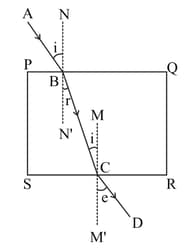Laws of Reflection of Light
Laws of Reflection of Light: Overview
This topic covers concepts such as Reflected Ray, Angle of Incidence, Normal to the Plane Mirror and Laws of Reflection etc.
Important Questions on Laws of Reflection of Light
The angle of incidence is equal to the angle of _____.
A ray incident on a plane mirror is reflected in a direction such that the angle between the incident and the reflected ray is . What are the angles of incidence and reflection
Observe the given figure and name the incident ray.

The angle between the normal and the_____is called the angle of reflection.
Is there a relation between angle of incidence and angle of reflection? Explain.
Explain the term plane of reflection.
The normal line divides the angle between the incident ray and the reflected ray into two equal angles.
What does normal line to the mirror means?
State the laws of reflection. Describe an experimental method to verify the laws of reflection of light.
Two plane mirrors are aligned parallel to each other, as shown in the figure. A light ray is incident at an angle of 30° at a point just inside one end of a mirror. The maximum number of times the ray undergoes reflection. before it emerges out is

The incident ray, reflected ray and _____ at the point of incidence lie in the same plane.
Angle of incidence is always equal to the angle of _____ for opaque surfaces.
The incident ray, reflected ray and normal at the point of incidence lie in the same plane.
The angle of incidence is always equal to the angle of reflection.
What are the two laws of reflection.
What is normal in plane of reflection.
The incident ray, reflected ray and normal do not lie in the plane of reflection is called plane of reflection.
The plane in which the incident ray, reflected ray and normal lie is the plane of reflection.
Name the components of plane of reflection.
